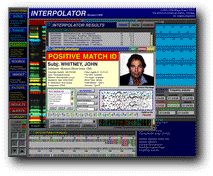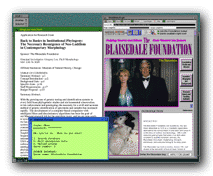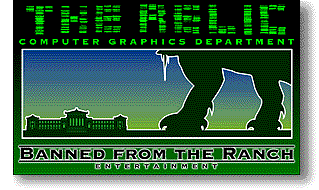About Our Work
In THE RELIC, a computer is featured as the tool used to ascertain the physiological and genetic makeup of the Kothoga creature. Ostensibly created by the main character, Dr. Margo Green, a proprietary system called the Interpolator analyzes the DNA chain of the specimen and compares it to all known DNA chains in order to establish family, genus and species for that particular animal. In reality, limited versions of such systems do exist--but
they required hundreds of computers that have to crunch numbers for many days or weeks to come up with a solution. Even then, their findings will be incomplete, because not all of DNA data for all of the animals on Earth have been catalogued. But in the fictional world of THE RELIC, one computer does the entire job.
BFTR was engaged to produce the Interpolator software that would be featured in the film, along with a labful of other DNA analysis computer graphics. Determined to base the system on reality, we delved into current DNA research and studied up on state-of-the-art biotechnological concepts in order to create both a convincing lab environment and an accurate projection of how Margo's (only currently) fictional computer software might really work.
We picked the brains of a number of geneticists and molecular biologists (Van's sister is in fact a molecular biologist in Boston, and she was able to turn us  on to people who actually do evolutionary biology) for how their "wish list" software system might actually work, and also contacted Perkin Elmer, an actual genetic analysis hardware manufacturer. In a product placement arrangement with Paramount, Perkin Elmer provided a number of authentic analysis workstations for use on the set. The system is designed so that a sample of DNA can be applied, along with chemical reagents that will multiply the DNA for analysis. Other enzymes cut the DNA and start chain reactions to isolate and visually display the order of the nucleotides, in a process called electrophoresis. The idea behind the Interpolator in the movie is that all of the information goes directly into Green's computer. She supposedly loads the data, and then the Interpolator figures out what it is. The funny thing about the real Perkin Elmer equipment was that of course, nobody on set really knew how to use it, and it needed a special 220-volt power line and was too noisy to run on a set where we were recording dialogue. So we "animated" the mechanical parts of the machine, the arms and pipettes and so on, by loosening the servo motors and puppeting the sliding mechanical arm with monofilament that stage effects supervisor Garry Elmendorff's team threaded through the machine!
on to people who actually do evolutionary biology) for how their "wish list" software system might actually work, and also contacted Perkin Elmer, an actual genetic analysis hardware manufacturer. In a product placement arrangement with Paramount, Perkin Elmer provided a number of authentic analysis workstations for use on the set. The system is designed so that a sample of DNA can be applied, along with chemical reagents that will multiply the DNA for analysis. Other enzymes cut the DNA and start chain reactions to isolate and visually display the order of the nucleotides, in a process called electrophoresis. The idea behind the Interpolator in the movie is that all of the information goes directly into Green's computer. She supposedly loads the data, and then the Interpolator figures out what it is. The funny thing about the real Perkin Elmer equipment was that of course, nobody on set really knew how to use it, and it needed a special 220-volt power line and was too noisy to run on a set where we were recording dialogue. So we "animated" the mechanical parts of the machine, the arms and pipettes and so on, by loosening the servo motors and puppeting the sliding mechanical arm with monofilament that stage effects supervisor Garry Elmendorff's team threaded through the machine!
Shots of the Interpolator at work reveal on-screen computer graphics that incorporate the colorful DNA gel images recognizable to any biochemist. In order to make this rather abstract comparison process visually dynamic in the sequence, we had these images flip through the screen, like cherries on a slot machine, as the software system attempts to find possible matches. The nice thing about the way we were able to create the program was that Penelope Ann Miller was able to act with the computer. Instead of having to time her performance to a pre-recorded video playback, she had control keys that allowed her to change the images on the screen whenever she was ready. As long as she hit the right keys, the results she was looking for would come up. We also had the ability to create or reprogram graphics on the set, to give Peter and the actors total flexibility. In one instance, we were able to program some of James Whitmore's more technical dialogue into a graphic like a cue card!
To create those images on various monitors throughout the set, we used a combination of graphics and animation software packages, including Adobe Photoshop, ElectricImage and in-house custom programs. For example, the art department was able to product place a real Leo/Leica scanning electron microscope in a pivotal lab scene, but again we couldn't really turn it on and use it for a variety of reasons, so we had to give it life entirely through our screen graphics. We mimicked and embellished upon the machine's real interface and then created an entirely fictitious image of the virus on the underside of the plant leaves, using ElectricImage and  Photoshop to create a rotatable image of these spiky nodules with that characteristic electron microscopy look. Digital artist Allen Manning did the 3D work, while Van textured and compiled the frames into an interactive simulation of what the real machine could do.
Photoshop to create a rotatable image of these spiky nodules with that characteristic electron microscopy look. Digital artist Allen Manning did the 3D work, while Van textured and compiled the frames into an interactive simulation of what the real machine could do.
For the other more generic lab screens, we had the chance to blend realism with a little fun. We worked out exactly what each screen was supposed to be doing --monitoring a
polymerase chain reaction (PCR), cataloguing species, inventorying the specimen
collection, even running the fictitious Museum's website-- and then went to town on making it look real enough to hold up to closeups, even if the text and references seemed a little goofy: the security screens showed that the Museum had a "Hall of Squids"; and the website page had some really silly email and responses. There were references to Peter Hyams' earlier films all over the place: the Museum's corporate sponsor was Con-Am; it was located on Hanover Street; there was a rotating molecule simulation labeled
"polydichloric euthimal".
While nobody ever got a camera close enough to read these gags, at least we had the crew looking forward to seeing what new stuff we put into the graphics every day. In one instance, the attention to detail paid off: for a completely non-computer-oriented scene of the Greg Lee character preparing for the gala, we did a supposedly generic background screen for his computer in which he had pulled up a web page on the Blaisedales, the rich patron couple he sucks up to later in the film. When Peter Hyams saw this, he said "This is great! We can start the scene on a closeup of the screen and pull back to show Greg Lee doing his practice suckup dialogue. That way we can introduce the Blaisedale characters before we meet them later in the movie!"
Working with high-end computer workstations provided by Silicon Graphics and custom programming software, we were able to produce interactive computer displays that were synchronized to the film cameras on set by BFTR technical supervisor Josh Kirschenbaum and technician Glenn Cannon. Before running the programs and setting up monitors on the set, however, we did a test shoot, with Peter Hyams --who was the film's Director of Photography as well-- there to film the monitors and insure the graphics were reading properly on film. We set up three computers, each with a different color temperature, all running our graphics. Peter was able to look at them through playback and tell us exactly how to adjust them, which allowed for extra comfort once we got to the set. He knew going in that he didn't have to worry about how blue or how red the monitors would appear, because they were all pre-set to work with his lighting and filters.
We ended up creating several dozen screens for the film, most of them hero graphics with lots of closeup coverage. In addition, we made a bunch of transparencies and had the art department fabricate a number of vacuform plastic dummy SGI monitors, so that we could have the Kothoga go tearing through the set smashing things without endangering the real equipment.
Multimedia
Our Credits

THE RELIC
Screen Graphics and On Set Supervision by
BANNED FROM THE RANCH ENTERTAINMENT |
|
Computer Graphics Supervisor
VAN LING
Computer Graphics Producer
CASEY CANNON
Technical Supervisor
JOSH KIRSCHENBAUM
|
On-Set Technician
GLENN CANNON
Digital Artist
ALLEN MANNING
Coordinator
DIANE "SISSY" JONES
|
Production Assistant
STEVEN SIMON
Science Consultants
DR. NICOLE T. PERNA
DR. LEONA LING
|
|
|
Resources
- Cinefex Magazine, Issue 69, covers the visual effects of THE RELIC, as well as DANTE'S PEAK and STAR TREK: FIRST CONTACT. Call (800) 434-3339 for back issues and subscription information.
- VFX HQ's coverage
of THE RELIC contains a review of the visual effects from the film, provided by VIFX. http://www.vfxhq.com/1997/relic.html
Perkin Elmer
the hardware manufacturer whose equipment was the basis for the computer systems used in the film.